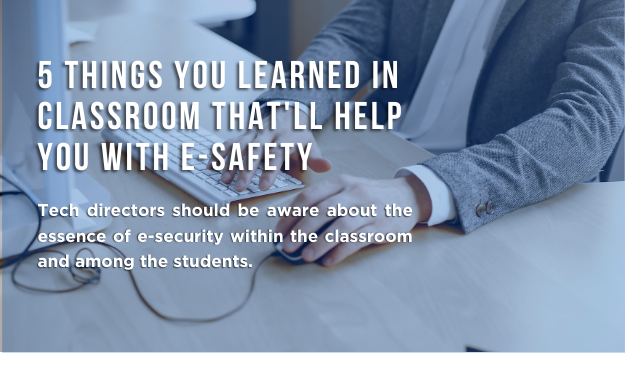
As technology and our use of it continues to grow, educators’ approach to internet protection in the classroom has shifted. In the past, internet security lectures on digital citizenship centered more on dos and don’ts, such as building stable codes and not chatting online to strangers.
Although protected passwords are necessary for consumers of all ages of technology, and strange danger is nothing to be taken lightly, most internet security dilemmas are far more complex.
The best lessons on internet security understand these subjects’ complexities and help students cultivate the talents and patterns of logical thought to overcome the dilemmas they face.
In our culture, technology is omnipresent, so it just makes sense that we need to educate our children about software and how to use it properly.
As an instructor, with how tech-savvy most children are these days, you might assume that your students know more about the new technology than you do.
But it’s more than just learning how to beat a game or root a handset or torrent a film to learn about technology. E-safety in the teaching program should play a significant role.
Why is E-Safety a Big Deal?
Kids, by electronics, are subject to a lot of stimuli. This is a positive idea in many situations. Technology can be a powerful learning platform for studying subjects, teaching themselves, and getting entertainment worldwide.
Children must know how to use technology and know-how to use it correctly. Protecting our children online is our duty and one which cannot be taken lightly.
The Internet is one of the best instruments for developing student learning on the planet. It is a variety of knowledge waiting for greedy minds to devour it.
It can also be a risky spot, though, where learners find themselves isolated and uneducated on coping with sticky circumstances. To show yourself and your pupils how to be better and safer users of the World Wide Web, use these 5 Best Internet Safety Guides for tech directors.
- E-Safety is About Modelling, NOT Restricting
It can seem better to use only specific “child protected” websites when using the software in the classroom and to ban others, use parental controls on the tech that limit the use of a child, or hover over kids while using the Internet. However, the critical point you need to note is that it’s your responsibility to teach as a teacher.
If you only encourage children to use technology closely supervised, that does not allow errors, so you do not model real-world actions. In essence, this means that you don’t teach children to make the right choices. In truth, you don’t let them make any choices at all.
That’s not to suggest that kids should all be free to rule. But a good lesson plan should show children how to make the best e-safety choices instead of only minimizing their use so that they don’t test safety tactics!
- Parental Involvement is a Must
As a teacher, you probably spend a few hours a day with a child at best, during which you take them home (maybe gratefully!). For this reason, e-safety mustn’t only be taught to kids but also their parents. Most parents are also not knowledgeable of e-safety techniques.
- Teach “Digital Citizenship.”
E-safety is for so much more than merely selecting good passwords and stopping harmful websites and malware. A core part of the program should be the definition of digital citizenship.
In the online world, the digital citizenry is essentially citizenship. How to handle strangers, how to defend yourself, what is acceptable, and what is not, lessons learned in real life to children that can quickly be adapted to their cyber lives.
Consider teaching a tutorial on leaving a healthy digital legacy as part of this. Based on the photos they want to share, the items they purchase, the conversations they have, and the blogs they frequent, the Internet never forgets (but kids certainly do), and people create an online identity. Children need to know that they have a preference when it comes to what kind of credibility they can gain online.
- Know What to Do When Things Go Wrong
When you find out a kid is being cyberbullied, what should you do? When you think a kid is engaging in something, they shouldn’t be online, what should you do? If you see inappropriate photographs on a child’s mobile, what do you do? If a kid mentions finding something inappropriate online, what do you do?
Before something arises, you should know what to do in these situations. Check the online protection protocol for your school with your headteacher or principal. You should be in a position to respond quickly anytime a crisis arises.
Depending on the nature of the offense committed, there are guidelines for disclosing potential criminal offenses. Your school should include a resource folder that contains all the applicable news agencies’ contact details (and if it doesn’t, make one!).
- Don’t Be Afraid to Go Real World
Finally, as most teachers know, the lessons that encourage children to learn things for themselves are the most memorable ones. There have been several teachers organizing initiatives that would encourage kids to see how easily information (even incorrect information) travels online–the traditional way of doing this is to put a photo on Facebook to see how much it is posted.
But by role-play or imaginary scenarios, you can also teach real-world examples. Or try to send your children a simple written questionnaire that asks them questions such as their first pet’s name, their email addresses, their birthday, favorite color, the maiden name of their mother.
If the questions have been answered and you have gathered the sheets, ask them what they think the odds are that you can now break their internet codes (hint: there’s a 90% probability that you can). Exercises like this are essential to put home the sorts of lessons you teach.
And on a side note, consider that you are an example of the natural world yourself. This means you need to make sure that you abide by the guidelines that you set up.
Your accounts on social media should be private (and not open to your students). Proper attribution should be granted to the photographs and pictures you want to use with handouts and projectors.
For some fun lessons, teaching e-safety to children sure reveals! But more than that, it’s a worthy thing to teach and something that any kid can probably make use of.
